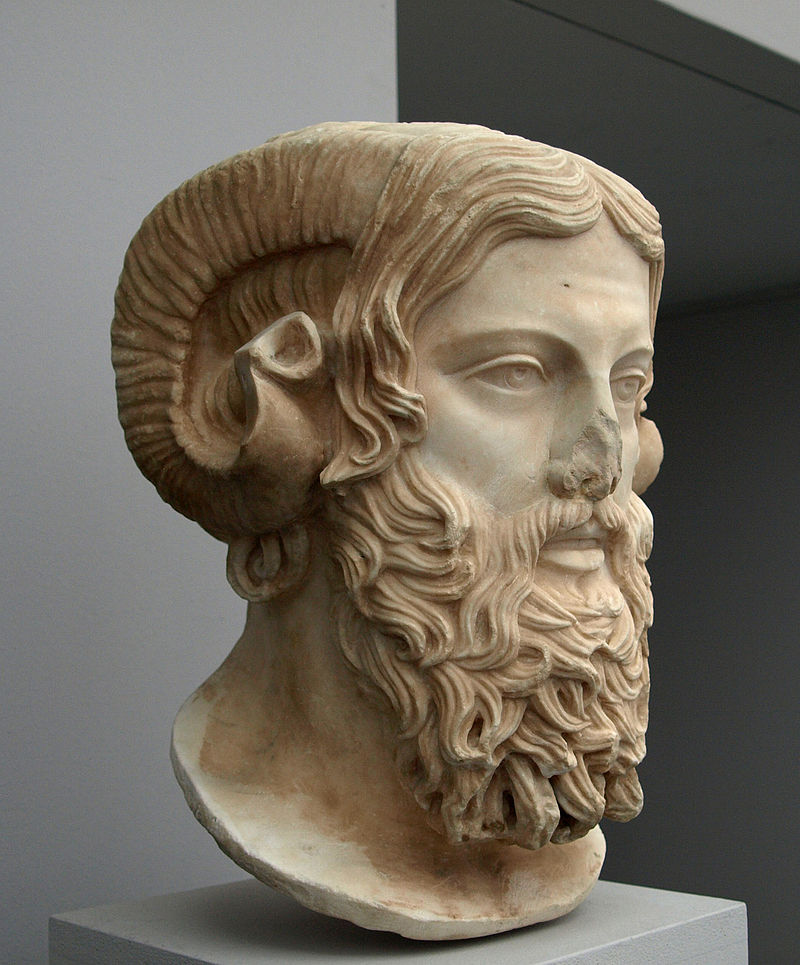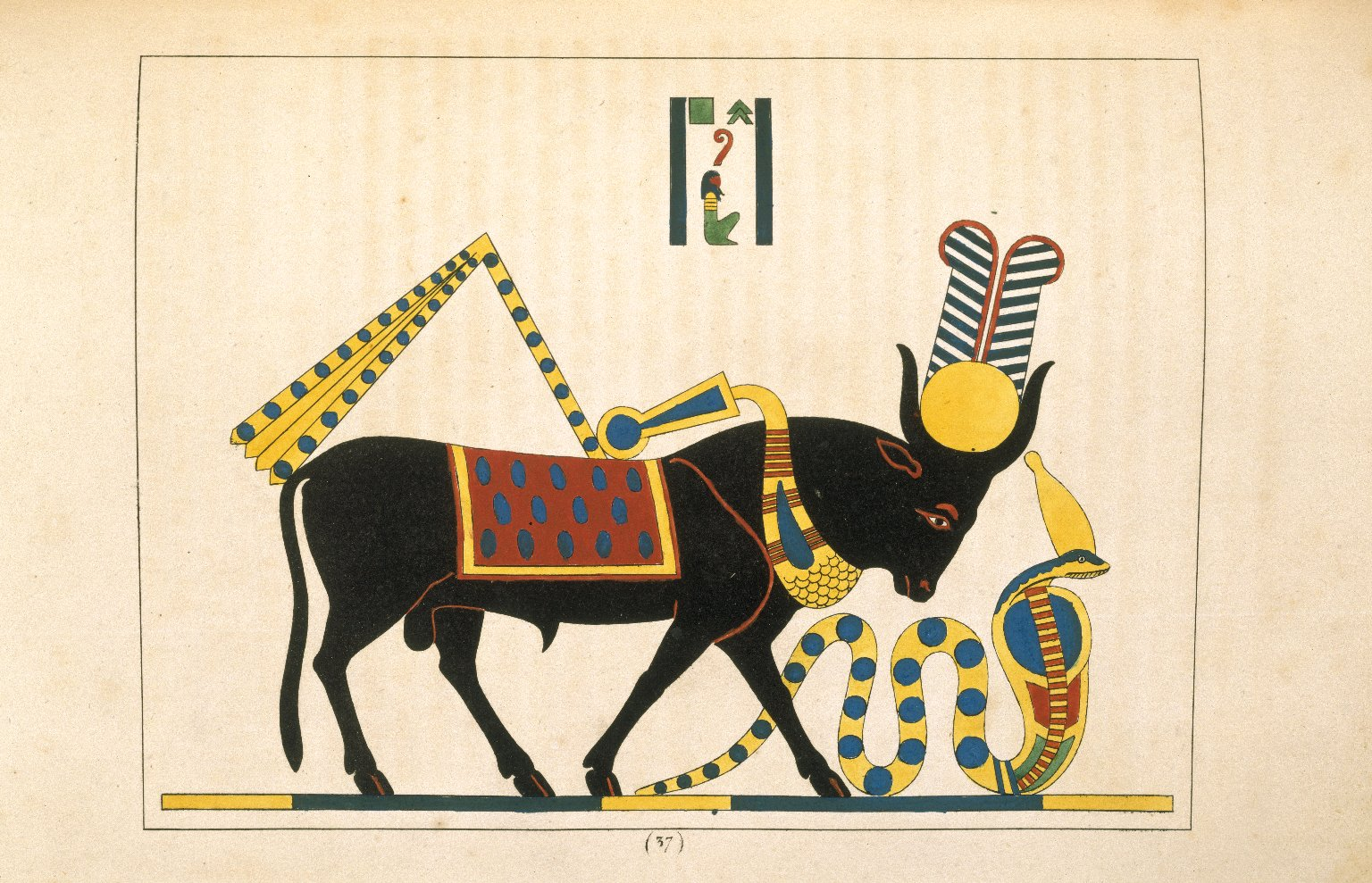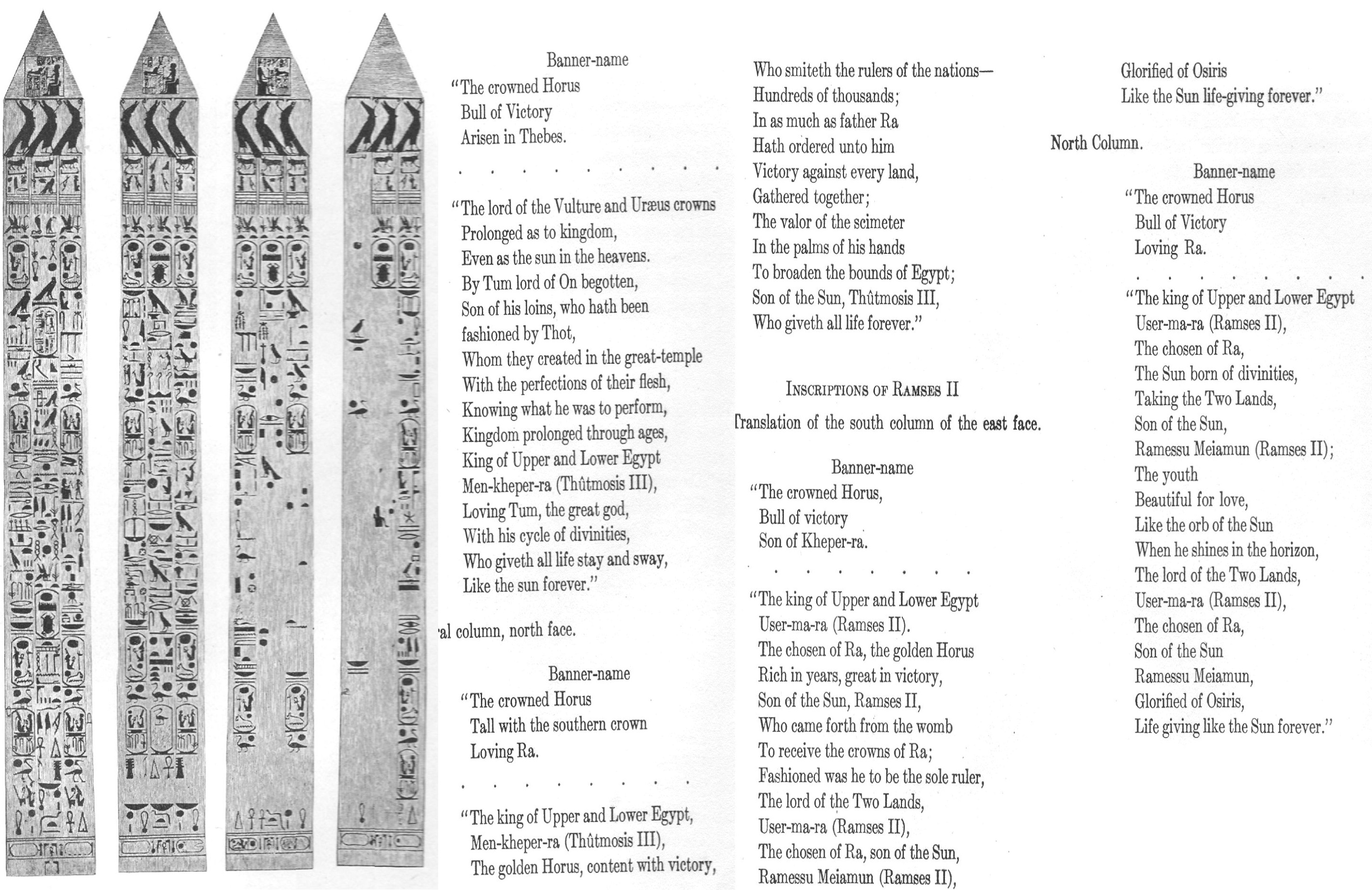created, & modified, =this.modified
tags:y2025libraryarchitecturehistory
rel: Library A Fragile History A History of Reading by Alberto Manguel Survey of Being Lost
Why I’m reading
I’m so curious about situating myself in these massive libraries of antiquity.
I’ve always heard of the LoA, and it’s tantalizing loss, but my actual understanding was just broad things and not specifics. I understand, to a degree, that LoA wasn’t wholly unique and that other libraries existed. I don’t think some arcane, indispensable knowledge that would revolutionize thought was lost. I’m approaching this from a place where even the mundane en-masse is intriguing, and understanding the architecture of a project is also intriguing.
I looked through a number of options for books on the subject (perhaps others I’ll visit) and this one seemed well regarded.
It’s such a consequential loss of information, when you look at how precisely valuable so much firsthand historical information is (the countless allusions too).
Birthplace of the Modern World
Antiquities are history defaced, or some remnants of history which have casually escaped the shipwreck of time. -Francis Bacon
Most take for granted, Athens and Rome completely dominated the classical world.
But this is, in fact, a distorted view of history, fueled by generations awed by the might of Rome and the ingenuity of Athens, and perhaps a little too keen to take native historians of both cities at their word.
The city of Alexandria, at its height, dwarfed both of these in wealth, population, artistic achievement.
It had safe harbors, a lighthouse, an emporium (market), and the greatest library and museum of antiquity.
It aimed to accumulate every book written, and and its zenith contained three-quarters of a million scrolls.
the single place on earth where all the knowledge in the entire world was gathered together—every great play and poem, every book of physics and philosophy, the key to understanding … simply everything.
Here were not only the works of the brilliant scholars of their own time but also those of their illustrious predecessors—of Homer, Pythagoras, and Herodotus, of Socrates, Plato, and Aristotle—names that might otherwise be unknown to us.
Info
Other libraries like the Library of Congress, and the British Library have more books (nearly all printed books in the last two hundred years between them) – but most of the knowledge of the the first hundred years of Western civilization is missing. These books were from the library of Alexandria, and only a handful have been discovered since the library’s tragic destruction.
Perhaps 1% of the works of the library survive.
Thought
The library was fragile? The written word itself, not fully copied or distributed was fragile.
Does the centralizing of such archives of knowledge have a problem too? We lost this knowledge because of its density in singular place. This is history.
Does amassing knowledge into singular entities (trained LLMs/archives) prove problematic always on macro-timescales? (Thinking of the PKD short story where the musician preserves his songs in the creatures around him.)
It would seem so, but also it provides greater access, so it is a damned equation?
Flour and Sand
History is a child building a sand-castle by the sea, and that child is the whole majesty of man’s power in the world. – Heraclitus
331 BC cries of thousands of birds heard, crisscrossing the sandy shore were lines of barley flour (used impulsively due to lack of Chalk in Egypt) – to lay out a new harbor, and around this harbor they were to describe an entire city.
Some said it was a bad omen that the flour was immediately eaten, but Aristander Alexander’s soothsayer, said it showed one day Alexandria would feed the whole world, “the city you are building will be a food-giver and nurse of the whole world.”
As with so much about Alexander’s life, it can be difficult to separate fact from myth in a story filled with omens and peopled by gods.
A smalling fishing village called Rhakotis existed there since the 13th century BC.
Alexander’s personal tutor was Aristotle.
Alexander became king at just 20 years of age, and King of Egypt at 23.

Gordian Knot
A complex and intricately tied knot dedicated to Zeus by King Gordius. A prophecy stated whoever could untie it would rule over Asia. Alexander sliced it with his sword. In another, he pulls the lynchpin and it unravels.
For Alexander the Mediterranean and not the Nile bound his world together, and he saw Rhakotis as a port on the coast that would provide supply and control of his empire.
Cult of the Libyan Ammon made a bridge between Alexander’s Greek roots (sneering at men who called themselves Gods) and Egypt (still theocratic, requiring divinity of their rulers)
The image of the god is encrusted with emeralds and other precious stones, and answers those who consult the oracle in a quite peculiar fashion. It is carried about upon a golden boat by eighty priests, and these, with the god on their shoulders, go without their own volition wherever the god directs their path. A multitude of girls and women follows them singing paeans as they go and praising the god in a traditional hymn.
At 32 his vast empire was tottering, weighed down by self-interest and infighting. He returned to Babylon, with omens of his impending death.
Just outside the city a Chaldean astronomer appeared before him and warned him that entering the city (or in some versions of the story, entering the city from the east) would bring about his death.
So powerful, so widely believed, were the prophecies of these men that they could easily become self-fulfilling.
When Babylonian astronomers predicted inauspicious times it was the custom for the priests to release a convict and place him on the throne as a “substitute king” in place of the real ruler. Then, any bad luck that befell the kingdom during this ominous time would fall on the shoulders of the criminal, not the king and hence the state. When the danger passed, the criminal would be executed, taking his ill fortune to the grave with him.
June 10, 323 BC Death
He’s stricken by fear of omens and misinterpretations. He drinks “too much unmixed wine” in commemoration of the death of Heracles.
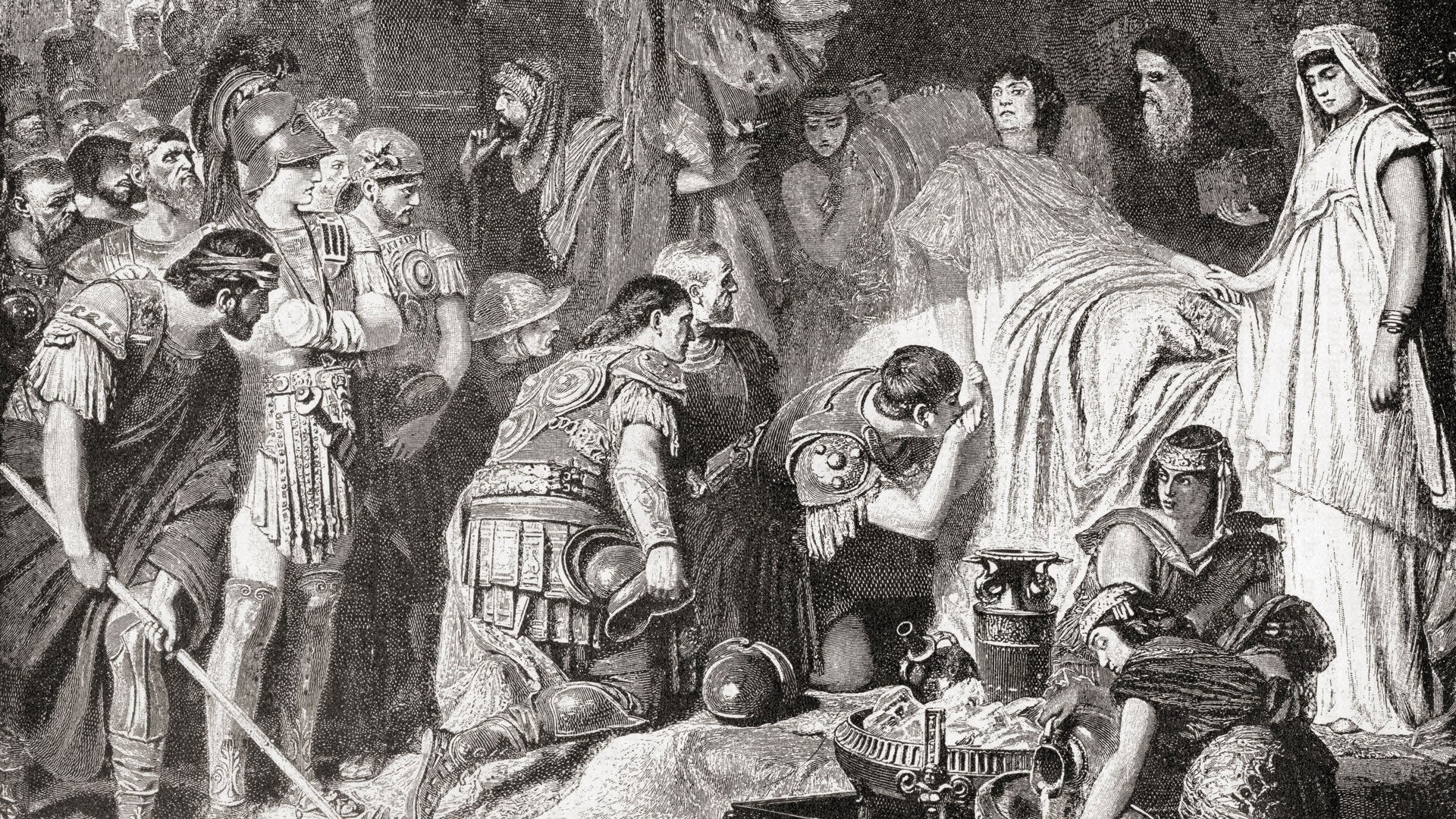
NOTE
Looking further, his actual death cause seems contested. It could have been typhoid, disease, poisoning, prior injury and other causes.
I even see recent thoughts his death was most famous case of pseudothanatos, or false death diagnosis –
increasing paralysis Alexander suffered, as well as the fact that his body needed less oxygen as it shut down, would have meant that his breathing was less visible. Because in ancient times, doctors relied on the presence or absence of breath, rather than a pulse, to determine whether a patient was alive or dead, Hall believes Alexander might have been falsely declared dead before he actually died.
Ptolemy, Alexander’s childhood friend, confidant and senior general had been with him from the start and accompanied him to the oracle of Ammon. The empire was too large so they decided to divide it into three principal parts, which would regularly meet to keep affairs on an even keel.
The other generals rejected this, wanting to be the sole ruler.
Alexander’s body began taking on aspects of divinity.
Although the king’s body had lain in the coffin for 6 days in scorching heat, there was no sign of decay when the Egyptians and Chaldeans came to embalm it. A golden sarcophagus was filled with perfumes, and on Alexander’s head was placed the insignia of his rank.
Stealing a God
Ptolemy quietly secured his position as ruler of Egypt.
An elaborate carriage carries the deceased king’s body
there was a purple banner blazoned with a golden olive wreath of great size and when the sun cast upon it its rays, it sent forth such a bright and vibrant gleam that from a great distance it appeared like a flash of lightning.
The degree to which Alexander thought he was a god is unknown, but he did decide to not be buried with his earthly ancestors in Aigai but at Siwa with his “divine father, Ammon”.
Ammon
Amun was identified as a form of Zeus, and Alexander referred to Zeus-Amon as his true father, and after his death he is depicted with the Horns of Ammon, as a symbol of his divinity.
Ptolemy knew Alexander would be the centerpiece of his new Egyptian empire and redirected the procession towards Egypt. The center of this would be Alexander’s founded city, Alexandria.
Dinocrates lay out the city, following ideas of Hippodamus - the Greek architect
*the first who, not being actually engaged in the management of public affairs, set himself to inquire what sort of government was best; and he planned a state, consisting of ten thousand persons, divided into three parts, one consisting of artisans, another of husbandmen, and the third of soldiers; he also divided the lands into three parts, and allotted one to sacred purposes, another to the public, and the third to individuals.
Perdiccas wished to maintain a single rule and attacked, but Ptolemy’s purported heroics forced retreat. Later Macedonian troops mutinied and assassinated Perdiccas.
This marked the end of the old rule. Alexander’s heirs were murdered (mother, wife, half brother, infant son). In Greece and Macedon the antigonids ruled their homeland, and amongst others in Egypt Ptolemy intended to found his own dynasty.
Egypt Reborn
Ptolemy worked to establish Serapis.
Apis, the bull god of the city was worshipped. The animal had come to represent the incarnation of Osiris the lord of the dead. When the bull died, the whole of Egypt went into 70 days of mourning and fasting, with a mummification of the beast and lavish funeral.
Sometimes the body of the bull was mummified and fixed in a standing position on a foundation made of wooden planks.
Auguste Mariette delves into the tomb in the 1800s.
After their lavish, almost pharaonic burial, word would have gone out to the priests that a new Apis had to be found, and the Nile Valley would be scoured in the search for a calf born under just the right circumstances. Herodotus says the priests were looking out for the “calf of a cow which is never afterwards able to have another. The Egyptian belief is that a flash of lightning descends upon the cow from heaven, and this causes her to receive Apis”.
The calf would need to be black with a white diamond on its forehead, eagle back, a scarab mark under the tongue and double the number of hairs. This would be their god returned to them. The calf mother would be revered as Isis Cow.
Thought
I’m reminded of Watching Animals in Film - Artifice. What a strange circumstance to be put in for these cows…
Ptolemy wanted not only to establish a Greco-Egyptian cult as quickly as possible, but also to locate its center to his new capital Alexandria, away from the influence of the old temple administrations.
Hellenistic afterlife was dull, gray place – a dusty land of regret where the dead looked back on what they had, hadn’t done in life.
The Egyptians looked forward to death, where the best in life was made eternal.
The Legacy of Aristotle
All men by nature desire to know - Aristotle
Aristotle was a profound influence on both Alexander and Ptolemy.
Alexander was a great devourer of books, often running out of material on campaigns and frantically sending for more.
Plato’s nickname for Aristotle was “the Reader.”
Death of Socrates
The Trial of Socrates (399 BCE) was held to determine the philosopher’s guilt of two charges: asebeia (impiety) against the pantheon of Athens, and corruption of the youth of the city-state; the accusers cited two impious acts by Socrates: “failing to acknowledge the gods that the city acknowledges” and “introducing new deities”.
Socrates’ pupil Plato:
Ten years or so before his death, it is said, Socrates had a dream one night. A young bird fell exhausted into his lap, and then in front of him it grew at great speed into a fully fledged swan and flew away. The next day Plato appeared at Socrates’ school and asked to enroll as a pupil.
Aristotle came to Athens to study under Plato when he was about 18 years old. He increasingly valued knowledge gained by senses, making him an empiricist and laying the path for scientific method.
He tutored Alexander up to his rise to the throne.
It is perhaps this that led to the tales that Aristotle determined to put a stop to his protégé’s rise, his unseen hand controlling events in Babylon during Alexander’s last days, bringing him to his death.
Pliny tells us that Alexander gave Aristotle control of all the hunters, fishermen, and fowlers in his empire, and made him overseer of all the royal forests, lakes, ponds, and cattle ranges, as recognition of his tutor’s masterly knowledge of all things natural. It’s also reported that Alexander sent many books and treasures back to Aristotle from the libraries of Babylon, Persia, and India.
City of the Mind
Theophrastus brushes it off:
Theophrastus had become a star, an international scientific celebrity, attracting students from all over the ancient world. At one time he is said to have had two thousand pupils. During his thirty-five-year tenure there he became so popular with the Athenians that when the old charge of impiety was brought against him he, unlike Socrates and Aristotle before him, simply brushed it off and continued teaching.
The strength of Athens, to Demetrius was not democracy but its philosophers. The center of the city should be a museum – literally “the place of the Muses” goddesses of poetry, music, dance, liberal arts and sciences where both should be taught and extended by observation and experiment.
Euclid of Alexandria was born in 325BC, and his book Elements remained relevant into the 20th century providing some of the basis for NASA’s lunar missions.
Human dissection was anathema in Greece, but in Alexandria it was more open. Mummification had involved the removal of all soft organs except the heart, which was considered the center of intelligence and feeling.
In casting aside the magical beliefs, Herophilus describes the linked functions of the brain and nervous system, relocating the center of thought to the brain.
Greek Pharaohs
Ptolemy appointed his son Ptolemy II as joint ruler. Ptolemy crowd his achievement with writing a book.
His book survived for centuries, and its eventual loss is one of the greatest literary tragedies of all time. Yet the very fact that he, a divine king, should dedicate his last years not to statecraft but to literature was a near-perfect sign of the times.
Three years later, he died age 84.
Seeking a throne for the third time, Arsinoe II proposed marriage to Ptolemy, her full brother. Ptolemy now had to choose. Stay true to his Greek roots and shy away from what any Macedonian would certainly have considered incest, or take the opportunity to consolidate his power, free from the influence of alien wives or suitors, and make Ptolemaic rule an entirely family affair. Fortunately for both of them, they lived in a country with a two-thousand-year precedent for this. Egyptians not only approved of incestuous royal marriages, they preferred them. Royal incest fitted into their religious cosmology and had been widely practiced by pharaohs at the height of Egypt’s power. Though her motives were Greek, Arsinoe could not have made a more Egyptian move, so she took a throne for the third time as wife and queen to her brother, the couple taking the epithet “Philadelphus” (brother-loving).
The leading intellectual was Theocritus, an influential poet who originated the form of poetry known as the pastoral idyll. Rather than telling stories with characters and action, as those preceding him, he created pictures of rustic life in dramatic form.
Sweeter, shepherd, and more subtle is your song Than the tuneful splashing of that waterfall Among the rocks, If the Muses pick the eye As their reward, you’ll win the hand-raised lamb; If they prefer the lamb, the ewe is yours. - Idylls 7
Also Sotades, sometimes credited with invention of the palindrome, and Sotadic verse which has the opposite meaning when read backwards.
Also Lycophron whose word use was obscure – “It is so riddled with bizarre, little-used words and words invented by Lycophron himself that even in his own lifetime he became known as “Lycophron the Obscure.””
The Lighthouse - Beacon on Pharos
Sostratus was the builder – proposed a structure on such grand scale. It was to be made of granite and limestone blocks, faced with white marble. It would be at least 400 feet, the height of a modern forty foot skyscraper. It had an observation level where the people of the city might enjoy the view, and at the top a bronze statue of Poseidon, god of the sea, leaning on his trident. Int he day it reflected the sun, in night a great bonfire’s light would be reflected by a great mirror.
Pharos is an oblong island, very close to the mainland. The [eastern] extremity of the isle is a rock, which is washed all round by the sea and has upon it a tower constructed of white marble with many stories and bears the same name as the island. This was an offering by Sostratus of Cnidus, a friend of the king’s, for the safety of mariners, as the inscription says: for since the coast was harbourless and low on either side and also had reefs and shallows, those who were sailing from the open sea thither needed some lofty and conspicuous sign to enable them to direct their course aright to the entrance of the harbour.
Possibly apocryphal, but Sostratus first inscribed his words into the dedication stone after completion, hoping that in time the plaster would decay revealing his words, “Sostratus, son of Dexiphanes the Cnidian, dedicated this to the Saviour Gods, on behalf of all those who sail the seas”
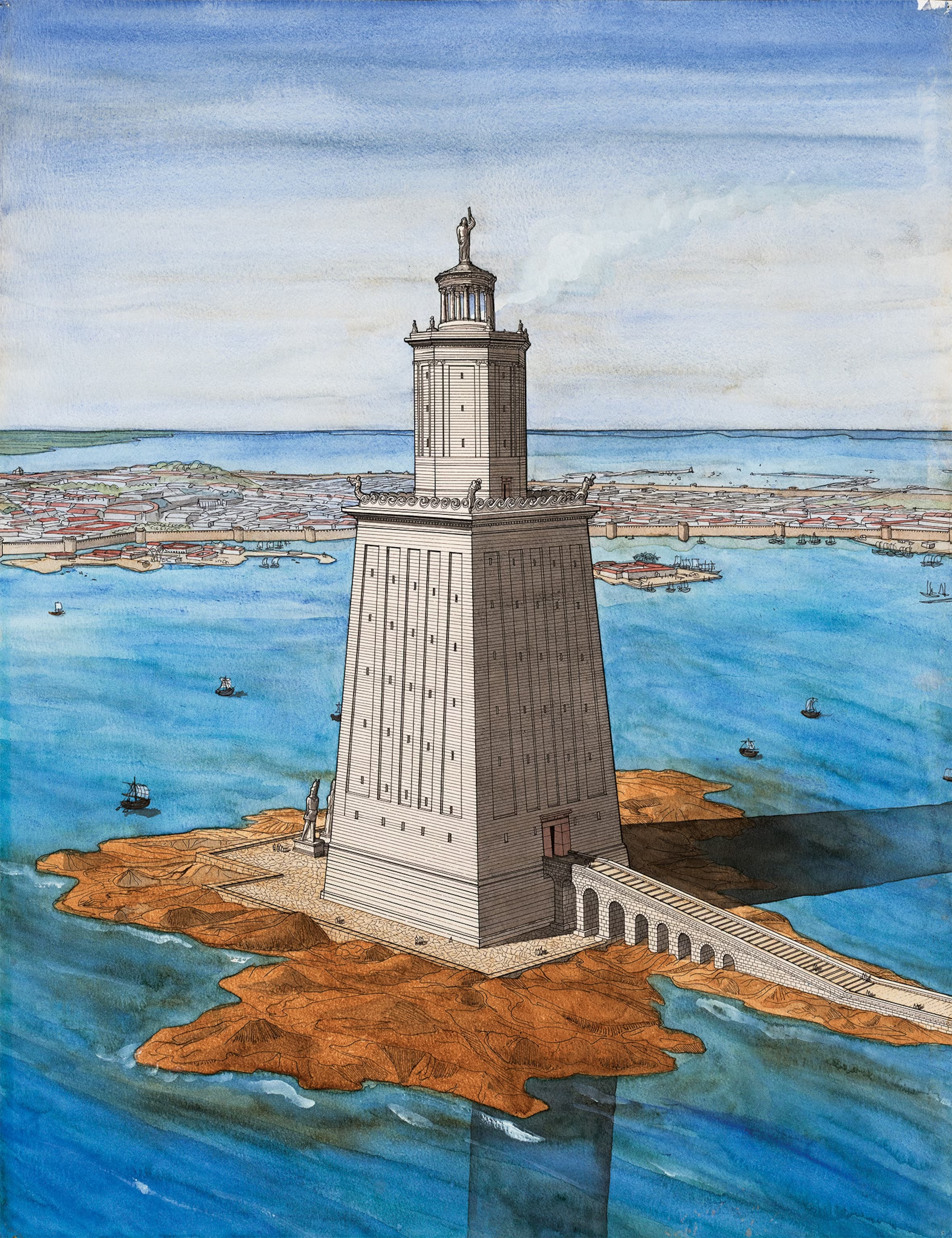
The lighthouse is described as standing in AD 1165, changed but with Poseidon’s statue still atop.
It fell to ruin, as described in 14th century:
At length we reached Alexandria [on April 5, 1326]… . I went to see the lighthouse on this occasion and found one of its faces in ruins. It is a very high square building… . It is situated on a mound and lies three miles from the city on a long tongue of land which juts out into the sea from close by the city wall, so that the lighthouse cannot be reached by land except from the city. On my return to the city in 1349 I visited the lighthouse again and found that it had fallen into so ruinous a condition that it was not possible to enter it.
The Music of the Spheres
Thought
How common was poisoning here?
It was a deadly mistake, as Laodice immediately poisoned her former husband and declared her son the new king.
Berenice’s Hair - Ptolemy III left for his campaign, and his wife went to a temple of Aphrodite. She promised to sacrifice her famous long hair for his safe return. She found the offering missing the next day. The only one to calm her was astronomer Conon, who said it had not been stolen but taken up to the heavens, now seen as Coma Berenices – Berenice’s Hair.

Aristarchus of Samos, Pythagoras and his mentor Thales of Miletus.
Before Thales those seeking answers to why things were occurring invariably referred to the gods.
People had only a hazy idea of the shape of the earth and the surrounding cosmos. Many believed the earth was flat and round, floating boatlike on an all- encircling ocean. They then added to the disk of earth sitting in its ocean-saucer some form of pillars or supports (the Egyptians placed them at the cardinal points and anthropomorphized them as the arms and legs of the sky goddess Nut), holding up the dome of the heavenly firmament which sun, moon, and stars traversed in a regular manner. Outside this cosmic eggshell some placed water, which could descend from above in the form of rain and snow or well up from below in springs, lakes, and wells.
All they saw, the fundamental nature of it was divine. But Thales preferred water – it being fundamental, solid liquid and gas and necessary for life. He believed quakes were the result of disturbances of the water of which the earth floated.
Pythagoras - “Noting that vibrating strings produce harmonious tones when the ratios of their lengths are whole numbers, he went on to arrange the universe into similarly harmonic groups of spheres, even claiming that the Music of the Spheres really existed, though we have lost the ability to hear this background noise. ”
The heavenly bodies played music as they moved past one another.
They ascribed particular significance to the number 10, as key to understanding the cosmos. They associated 1 with a point, 2 with a line, 3 with a surface, 4 with a solid.
Philolaus, pupil of Pythagoras stated about the setting and rising of the sun, that it was due to an invisible astral body. First, he had the earth spinning around a cosmic hearth, at the center to the universe. One the same sphere was another invisible object, a counter-earth responsible for generating certain eclipses. The next sphere was our earth, then the moon, the sun, the five known planets, and finally the sphere carrying all the fixed stars, bringing the total number of celestial spheres up to the desired mystical number ten.
If the universe is a machine, how does it work?
Aristarchus’ On the Sizes and Distances of the Sun and Moon
His calculations are off, but it seems the result of bad data and not bad math drawn from Euclid.
The Little O
Eratosthenes encounters the skeptics.
Skeptics proposed that one cannot rely entirely upon one’s senses and that the Stoical view that truth came from clear perception followed by certainty was wrong.
The scholars in the pharaoh’s pay were not needed to be specialists, but generalists – an explosion of work in a huge range of fields. The boundaries of science and art had not been so clearly fenced off. Men such as Eratosthenes might write about mathematics and poetry, astronomy and literary criticism, comedy and geography.
Little of his work survives, lost in the loss of the library.
He was concerned with understanding the shape and size of the world. Was it as Thales claimed, just a flat disk floating in an infinite ocean?
Thought
From the top of the forty-story Pharos lighthouse, where, no doubt, the philosophers of the museum sometimes gathered to gaze across the vastness of the sea and debate the nature of the world, a number of strange phenomena were visible, phenomena that would make any Skeptic question his senses.
People still struggle with this because we are limited.
But this vision of viewing from the lighthouse or some place extremely high where you can see out far, even now I am touched by this. I wonder if part of this is directly connecting with this person from the past, as I have nothing innate of my knowledge of the earth’s size and shape. It’s not like the calculations of Eratosthenes were genetically passed onto me, or he unlocked the shape of the earth.
I’ve not made the calculation myself, or seen it in entirety besides imagery.
So when I look from the top of the lighthouse, or see the eclipse I’m touching upon that distance, even in a miniscule way. In a sense it’s much closer to the actual realization of understanding the world than a calculation.
On the curvature of the earth,
It is obviously the curvature of the sea that prevents sailors from seeing distant lights at an elevation equal to that of the eye; however, if they are at a higher elevation than that of the eye, they become visible, even though they be at a greater distance from the eyes; and similarly if the eyes themselves are elevated, they see what was before invisible. This fact is noted by Homer, also, for such is the meaning of the words: “With a quick glance ahead, being upborne on a great wave [he saw the land very near].” So, also, when sailors are approaching land, the different parts of the shore become revealed progressively, more and more, and what at first appeared to be low-lying land grows gradually higher and higher.
To measure this, he knew there was a well in Syene. It has a wide stone-lined shaft that reached the water table. On one day of the year the midday sun would shine down the well, illuminating the bottom. As water lies flat, he knew the rays would be 90 degrees.
Among Ptolemy II’s huge civil service staff were the royal pacers, men trained to walk, or run, with exactly even, measured steps, so that large distances could be accurately measured.
In Alexandria he calculated the shadow of a sundial, and with this was able to calculate the circumference of the earth.
Using just a stick, a well, and a royal pacer, he had proved the earth was a globe and measured its circumference to within 318 kilometers (198 miles) of its true diameter while never leaving Egypt
He calculated the circumference of the earth to with 1% degree accuracy. He devised his sieve to calculate prime numbers.
He then proceeded to work on what he called Geography and mapped the earth.
Having discovered in 194 BC that he was beginning to lose his sight, this visionary thinker realized that he would soon no longer be able to read the collections in the library he had tended and enriched. Without this there was nothing. Unable to continue his work, he chose to starve himself to death. He was around eighty-one years old.
Eureka Factor
Give me but one firm spot of land on which to stand, and I will move the earth - Archimedes
All that mattered in Archimedes’ mind was the mathematics and exploration of pure thought, and his mechanical marvels were demonstration of these principals. He worked on how to calculate the volume of a sphere, estimate the number of sand grains in the universe etc.
Plutarch:
oftimes Archimedes’ servants got him against his will to the baths, to wash and anoint him, and yet being there, he would ever be drawing out of the geometrical figures, even in the very embers of the chimney. And while they were anointing of him with oils and sweet savours, with his fingers he drew lines upon his naked body, so far was he taken from himself, and brought into ecstasy or trance, with the delight he had in the study of geometry
Antikythera mechanism
The oldest known example of an analogue computer, it is a hand powered orrey (model of the solar system.)
In 2005, a team from Cardiff University led by Mike Edmunds used computer X-ray tomography and high resolution scanning to image inside fragments of the crust-encased mechanism and read the faintest inscriptions that once covered the outer casing. These scans suggest that the mechanism had 37 meshing bronze gears enabling it to follow the movements of the Moon and the Sun through the zodiac, to predict eclipses and to model the irregular orbit of the Moon, where the Moon’s velocity is higher in its perigee than in its apogee.
The quality and complexity of the mechanism’s manufacture suggests it must have had undiscovered predecessors during the Hellenistic period.
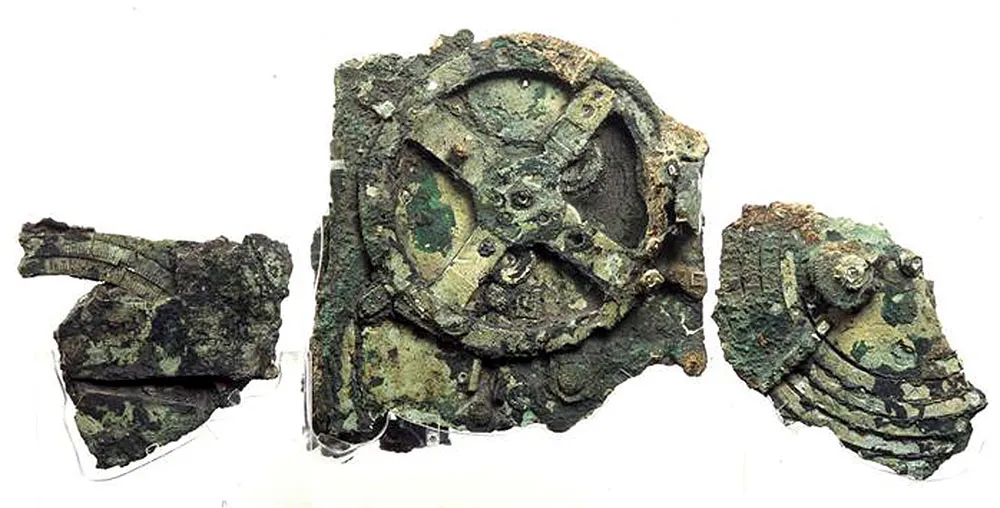
A Greek Tragedy
Sosibius, the king Ptolemy IV’s advisor, stood in the shadows. He filtered communications with the king, and probably orchestrated murders of those who might envy the throne.
Things brought down the Ptolemaic dynasty and the close to three century rule of pharaohs
- the success of early Ptolemies whose radical re-invention of the Egyptian state made the nation once again a treasure worth fighting for.
- the failure of their heirs to resist being seduced by the wealth and power they inherited
- Caesar
By the Great Harbor, in a palace flanked with ancient obelisks, a new pharaoh ruled. She would be Egypt’s last and perhaps the most famous: Cleopatra.
On Cleopatra:
For her beauty, as we are told, was in itself not altogether incomparable, nor such as to strike those who saw her; but converse with her had an irresistible charm, and her presence, combined with the persuasiveness of her discourse and the character which was somehow diffused about her behaviour towards others, had something stimulating about it. There was sweetness also in the tones of her voice; and her tongue, like an instrument of many strings, she could readily turn to whatever language she pleased. Plutarch, Life of Antony, in Parallel Lives
Caesar also attempted to play the peacemaker between the claimants to the throne, Ptolemy XIII and Cleopatra, whom he asked to appear before him. For Cleopatra it was a risk. Her forces were not in control of Alexandria or Egypt, and she did not have the support of the Alexandrians, or perhaps many Egyptians. Nor could she know what deal, if any, her treacherous brother had struck with the Roman. Her only hope was to use her skills to influence Caesar in private, so she got word to him asking for a secret audience. Smuggled back into the city under a coverlet (or rolled in a carpet, in some versions of the tale), she found herself in the presence of the most powerful man on earth. He was fifty-two years old, she was not yet twenty-two, but in a single night she persuaded him to make her queen again.
Caesar miscalculated, but his time with Cleopatra changed his mind.
Burning Library:
There is some confusion among the sources as to whether the great library in the royal quarter itself caught fire, or just the book warehouses on the waterfront, which housed volumes for export and those impounded from the ships. The lack of explicit references to the great library after this date might suggest that this fire was considerably more than a warehouse blaze—it was a disaster. By the time the fire was out, one source reports, some four hundred thousand papyrus scrolls had been lost. It was not the end of Alexandria’s library, but the great library itself would never recover its former importance, and the second, or “daughter,” library at the Serapeum would now begin to supplant it.
Caesar dies in assassination and Cleopatra. She finds her support in Mark Anthony. He had hunted down and killed Caesar’s murderers.
When a spy informed her that Octavian planned to move her and her children to Rome in three days, she prepared for suicide as she had no intentions of being paraded in a Roman triumph like her sister Arsinoe IV
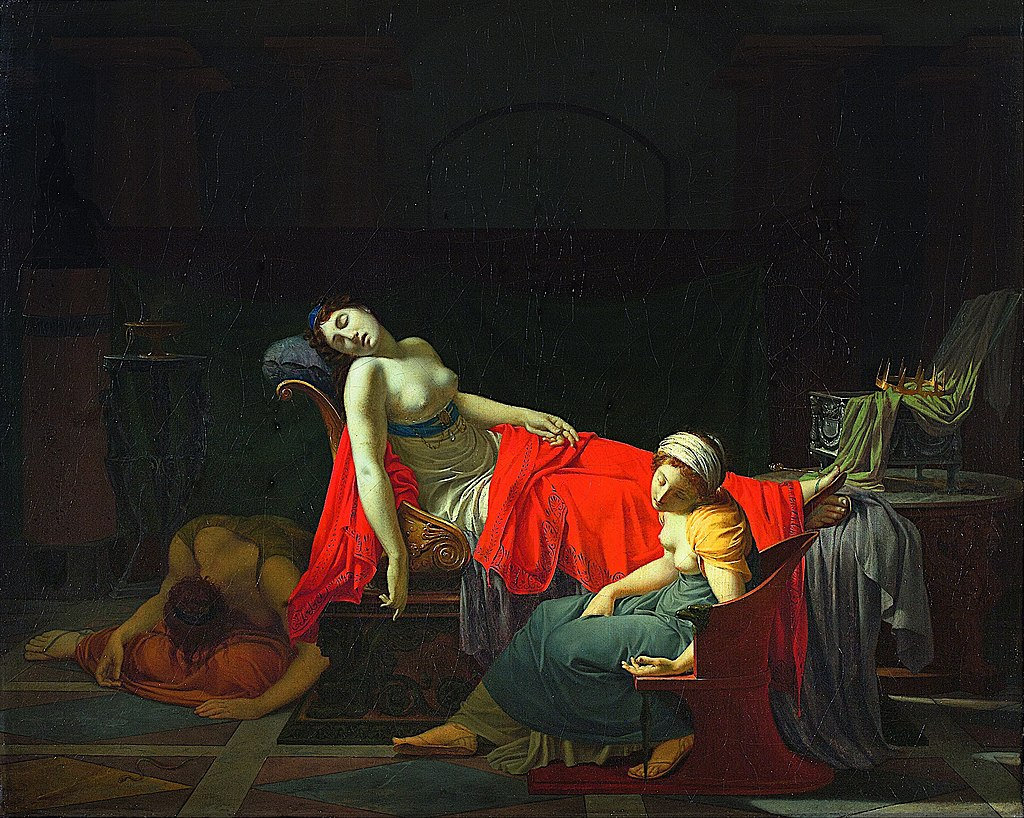
No venomous snake was found with her body, but she did have tiny puncture wounds on her arm that could have been caused by a needle
The Clockwork City
Cleopatra’s Needles, three ancient obelisks Augustus had brought from Heliopolis, one which is now in NY’s central park.
Thought
I recall spending a morning by this needle, when my friend was visiting from the UK. I later learned of another, in England, where she was from.
A time capsule buried beneath contains an 1870 census, a bible, a dictionary and the complete works of Shakespeare, a guide to Egypt and a declaration of independence. A small box with unknown contents were also placed, by the man who arranged the obelisk’s purchase and transport. The translation is as follows:
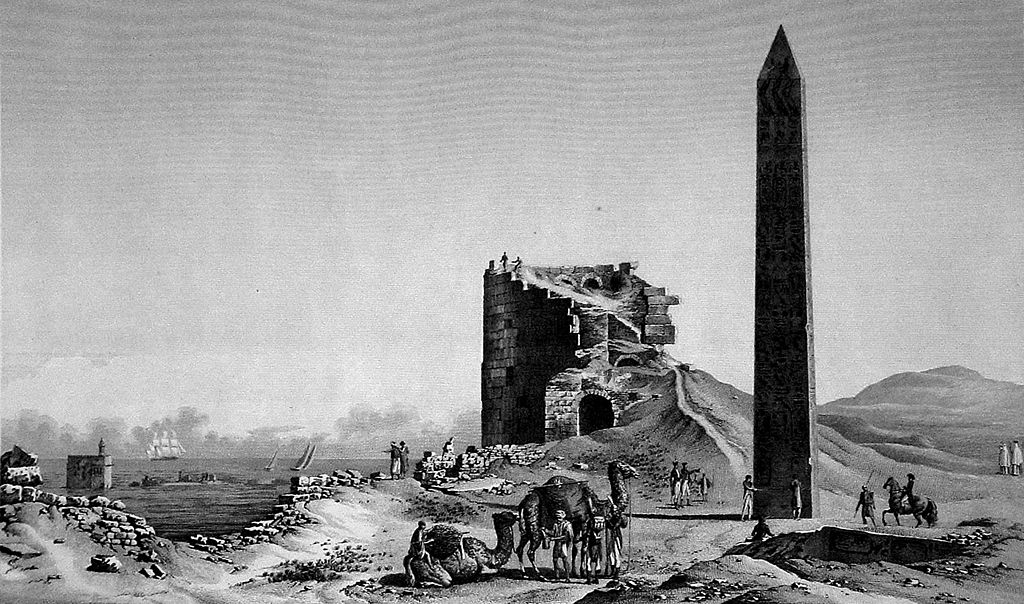 Hero was a builder of Automatons – automatically operated machines, which he used to delight and bemused the people of Alexandria in the 1st century AD.
Hero was a builder of Automatons – automatically operated machines, which he used to delight and bemused the people of Alexandria in the 1st century AD.
Automatons were part of Alexandrian life for centuries before, like the clanking automaton of parades of early kings.
For if every tool were able to complete its own task when ordered—or even anticipate the need—just as the statues of Daedalus supposedly did, or the tripods of Hephaistus which Homer says “entered of their own accord the assembly of the gods”—or shuttles could pass through the loom by themselves, or plectra play the harp, master craftsmen would have no need of assistants, and masters no need of slaves. Aristotle, Politics, book 1, chapter 4
Hero’s creations made the city appear to visitors as if a place of miracles.
Temple Doors opened by Fire on an Altar. The construction of a small temple such that, on lighting a fire, the doors shall open spontaneously, and shut again when the fire is extinguished. Let the proposed temple stand on a pedestal, ABCD. Hero of Alexandria, Pneumatica, machine 37
Hero also talks of a machine which allowed a group of mechanical songbirds to sing in a tree until a mechanical owl turned around to stare at them, at which point they fell silent in terror.
Dawn of the Iconoclasts
In second-century Alexandria, however, a new force was stirring which took a radically different view of man’s (and woman’s) destiny. During Ptolemy’s lifetime access to this protoreligion had been largely by word of mouth, with just a few accounts of the life and works of the new man-god in circulation.
Christianity, as preached by Jesus an passed onto his disciples challenged the established social order. It preached damnation for the rich and powerful, and salvation for the weak and oppressed.
Hypatia
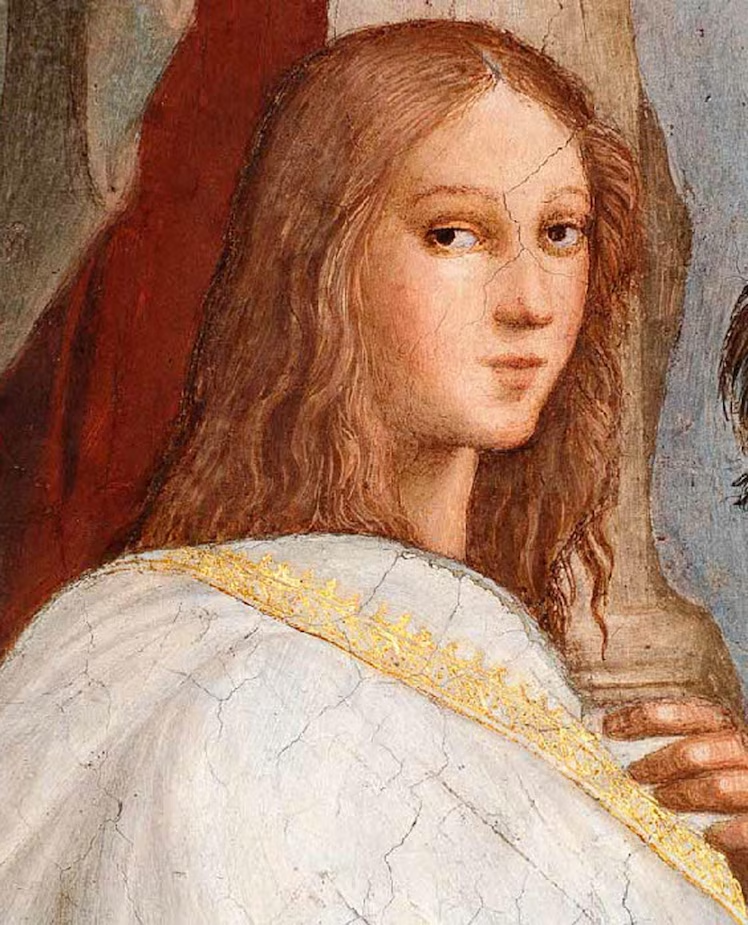
In 364 when the Roman empire split and Alexandria became part of the east half, the city was beset with fighting amongst Christians, Jews and pagans. In 391 the last remnants of the museum and library likely disappeared.
The last known member of the museum was Theon – Hypatia’s father.
Hypatia never married and likely led a celibate life, which possibly was in keeping with Plato’s ideas on the abolition of the family system. The Suda lexicon, a 10th-century encyclopedia of the Mediterranean world, describes her as being “exceedingly beautiful and fair of form… in speech articulate and logical, in her actions prudent and public-spirited, and the rest of the city gave her suitable welcome and accorded her special respect.”
She was tolerant towards both Christian and pagan alike, teaching them both (she was pagan).. She was killed by an angry Christian mob, due to rumors accusing her of preventing Orestes from reconciling with Cyril.
Synesius preserves the legacy of Hypatia’s opinions and teachings, such as the pursuit of “the philosophical state of apatheia—complete liberation from emotions and affections”
As described by Socrates of Constantinople
There was a woman at Alexandria named Hypatia, daughter of the philosopher Theon, who made such attainments in literature and science, as to far surpass all the philosophers of her own time. Having succeeded to the school of Plato and Plotinus, she explained the principles of philosophy to her auditors, many of whom came from a distance to receive her instructions. On account of the self-possession and ease of manner which she had acquired in consequence of the cultivation of her mind, she not infrequently appeared in public in the presence of the magistrates. Neither did she feel abashed in going to an assembly of men. For all men on account of her extraordinary dignity and virtue admired her the more
Damascius states that Hypatia remained a lifelong virgin and that, when one of the men who came to her lectures tried to court her, she tried to soothe his lust by playing the lyre. When he refused to abandon his pursuit, she rejected him outright, displaying her bloody menstrual rags and declaring “This is what you really love, my young man, but you do not love beauty for its own sake.
As her murder she was dragged, and stripped naked and murdered using ostraka or fragments of roof tiles, oyster shells, or simply shards. They also cut out her eyeballs, and set her on fire.
Distant Shore
A copy of Ptolemy’s Geographia begins a journey.
Planudes had turned the ancient words into maps, which were added to and improved on by the Byzantine court. One of these had itself found its way from the edges of Asia to a wealthy Florentine with the time and money to translate its Greek text back into the Latin that the scholars of Europe still understood. From Florence that map found its way to Rome, to the Apostolic Library of the pope, then the most powerful man on earth. And from there copies made their way across Europe, to the palaces and castles of the princes of Christendom
One of those would reach the Portuguese capital, Lisbon, where in 1484 a young explorer named Christopher Columbus was, like Ptolemy before him, beginning to think the unthinkable. What if the world was indeed a sphere? What if he could sail west to Cathay? What if the book he held in his hands that day was correct? A bo
